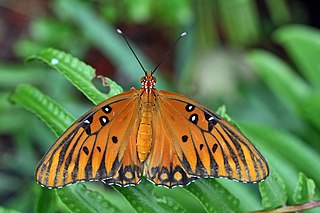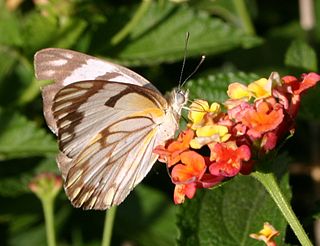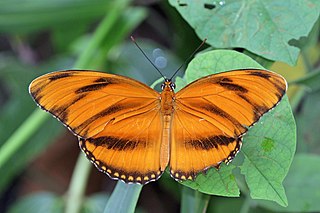
The Gulf fritillary or passion butterfly is a bright orange butterfly in the subfamily Heliconiinae of the family Nymphalidae. That subfamily was formerly set apart as a separate family, the Heliconiidae. The Heliconiinae are "longwing butterflies", which have long, narrow wings compared to other butterflies.

The Heliconiinae, commonly called heliconians or longwings, are a subfamily of the brush-footed butterflies. They can be divided into 45–50 genera and were sometimes treated as a separate family Heliconiidae within the Papilionoidea. The colouration is predominantly reddish and black, and though of varying wing shape, the forewings are always elongated tipwards, hence the common name.

Pierini is a tribe of butterflies within the family Pieridae.

Heliconius charithonia, the zebra longwing or zebra heliconian, is a species of butterfly belonging to the subfamily Heliconiinae of the family Nymphalidae. It was first described by Carl Linnaeus in his 1767 12th edition of Systema Naturae. The boldly striped black and white wing pattern is aposematic, warning off predators. It is the state butterfly of Florida.

Argynnini is a tribe of butterflies in the subfamily Heliconiinae, containing some of the fritillaries. This group has roughly 100 species worldwide and roughly 30 in North America.

Dryadula is a monotypic genus of the butterfly family Nymphalidae. Its single species, Dryadula phaetusa, known as the banded orange heliconian, banded orange, or orange tiger, is native from Brazil to central Mexico, and in summer can be found rarely as far north as central Florida. Its wingspan ranges from 86 to 89 mm, and it is colored a bright orange with thick black stripes in males and a duller orange with fuzzier black stripes in females.

Heliconius comprises a colorful and widespread genus of brush-footed butterflies commonly known as the longwings or heliconians. This genus is distributed throughout the tropical and subtropical regions of the New World, from South America as far north as the southern United States. The larvae of these butterflies eat passion flower vines (Passifloraceae). Adults exhibit bright wing color patterns which signal their distastefulness to potential predators.

Heliconius doris, the Doris longwing or Doris is a species of butterfly in the family Nymphalidae. It is known for being a polymorphic species which participates in various Müllerian mimicry rings throughout Central America and the Amazon rainforest. It is a species of special interest in biological science for the genetic basis and role of polymorphism (biology) in ecology and evolution.

Passiflora suberosa is a species of passionflower that is native to the Americas. It is commonly known as corkystem passionflower due to the corkiness of older stems. Other common names include corky passion vine, cork-bark passion flower, corkstem passionflower and corky passionfruit. In Latin America it is called Meloncillo. It is possibly also cryptic and have multiple species in one.

Dione juno, the Juno silverspot, juno longwing, or Juno heliconian, is a species of butterfly of the subfamily Heliconiinae in the family Nymphalidae found from southern United States to South America.

Heliconius ricini, the ricini longwing, is a butterfly of the family Nymphalidae. It was described by Carl Linnaeus in 1758. It is found from Venezuela and Trinidad to the Guianas and northern Brazil. The habitat consists of savanna-type areas.





